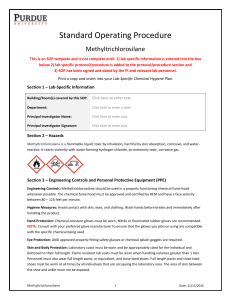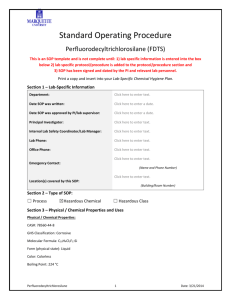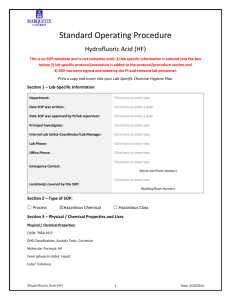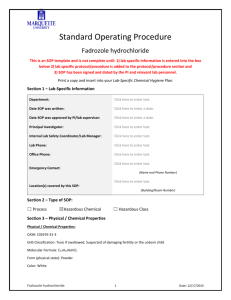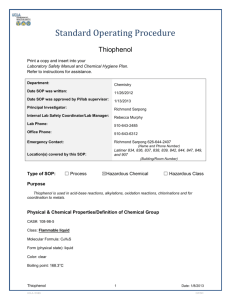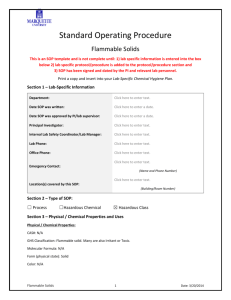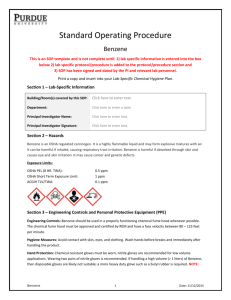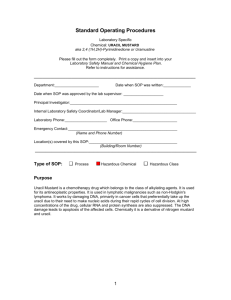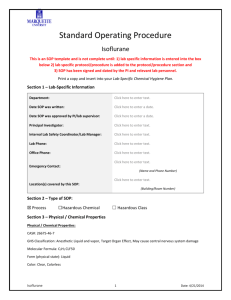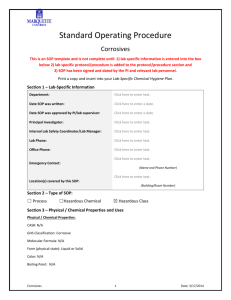Methyltrichlorosilane
advertisement
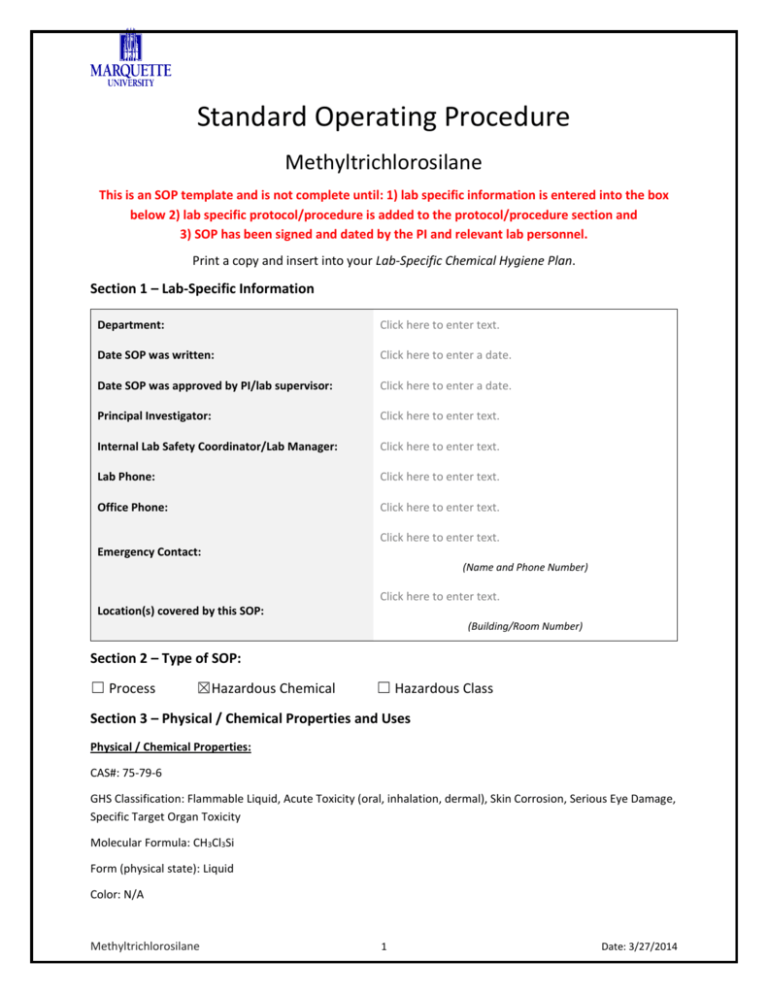
Standard Operating Procedure Methyltrichlorosilane This is an SOP template and is not complete until: 1) lab specific information is entered into the box below 2) lab specific protocol/procedure is added to the protocol/procedure section and 3) SOP has been signed and dated by the PI and relevant lab personnel. Print a copy and insert into your Lab-Specific Chemical Hygiene Plan. Section 1 – Lab-Specific Information Department: Click here to enter text. Date SOP was written: Click here to enter a date. Date SOP was approved by PI/lab supervisor: Click here to enter a date. Principal Investigator: Click here to enter text. Internal Lab Safety Coordinator/Lab Manager: Click here to enter text. Lab Phone: Click here to enter text. Office Phone: Click here to enter text. Click here to enter text. Emergency Contact: (Name and Phone Number) Click here to enter text. Location(s) covered by this SOP: (Building/Room Number) Section 2 – Type of SOP: ☐ Process ☒Hazardous Chemical ☐ Hazardous Class Section 3 – Physical / Chemical Properties and Uses Physical / Chemical Properties: CAS#: 75-79-6 GHS Classification: Flammable Liquid, Acute Toxicity (oral, inhalation, dermal), Skin Corrosion, Serious Eye Damage, Specific Target Organ Toxicity Molecular Formula: CH3Cl3Si Form (physical state): Liquid Color: N/A Methyltrichlorosilane 1 Date: 3/27/2014 Boiling Point: 66 oC Flash Point: 8 oC Auto-ignition temperature: > 404 oC (not pyrophoric) Lower Explosive Limit: 7.2% (V) Upper Explosive Limit: 11.9% (V) Relative Vapor Density: 5.16 (air = 1.0) Density: 1.273 g/cm3 at 25 oC Important Definitions: Flammable Liquid: Liquids having a flash point below 38oC (100oF). Combustible Liquid: Liquids having a flash point at or above 38oC (100oF) and no greater than 93oC (200oF). Flash Point: The minimum temperature at which vapors are formed on the surface of a substance in sufficient quantity to ignite when exposed to an ignition source. Boiling Point: The temperature at which the vapor pressure of a liquid equals the atmospheric pressure and the liquid changes into a vapor. Auto Ignition Temperature: The minimum temperature at which self-sustained combustion will occur in the absence of an ignition source. Lower Explosive Limit (LEL): The lowest concentration (percentage) of a gas or a vapor in air capable of producing a flash of fire in presence of an ignition source (arc, flame, heat). Upper Explosive Limit (UEL): Highest concentration (percentage) of a gas or a vapor in air capable of producing a flash of fire in presence of an ignition source (arc, flame, heat). Section 4 – Potential Hazards Flammable liquid, toxic by inhalation, harmful by skin absorption, corrosive, water-reactive (reacts violently with water forming hydrogen chloride, an extremely toxic, corrosive gas, CH3Cl3Si + H20 → CH3Si(OH)3 + 3 HCl) Section 5 – Personal Protective Equipment (PPE) Respirator Protection: Methyltrichlorosilane may only be used in a properly functioning chemical fume hood. Respirators should be used under any of the following circumstances: As a last line of defense (i.e., after engineering and administrative controls have been exhausted). When Permissible Exposure Limit (PEL) has exceeded or when there is a possibility that PEL will be exceeded. Regulations require the use of a respirator. An employer requires the use of a respirator. There is potential for harmful exposure due to an atmospheric contaminant (in the absence of PEL) Methyltrichlorosilane 2 Date: 3/27/2014 As PPE in the event of a chemical spill clean-up process Lab personnel intending to use/wear a respirator mask must be trained and fit-tested. This is a regulatory requirement. Contact EH&S 8-8411 regarding respirator clearance. Hand Protection: Gloves must be worn. Use proper glove removal technique to avoid any skin contact. Nitrile or fluorinated rubber gloves are recommended for low volume applications. Wearing two pairs of gloves is recommended. Carefully inspect gloves prior to use. Check the resources below for the most suitable glove. NOTE: Consult with your preferred glove manufacturer to ensure that the gloves you plan on using are compatible with the specific flammable or combustible liquids being used. Refer to glove selection chart from the links below: http://www.ansellpro.com/download/Ansell_8thEditionChemicalResistanceGuide.pdf OR http://www.showabestglove.com/site/default.aspx OR http://www.mapaglove.com/ Eye Protection: ANSI approved properly fitting safety glasses or chemical splash goggles are required. Only work with this material in a chemical fume hood equipped with a sash that protects the worker’s face and eyes from splash. Skin and Body Protection: Laboratory coats must be worn and be appropriately sized for the individual and buttoned to their full length (flame resistant lab coats must be worn when handling volumes greater than 1 liter). Laboratory coat sleeves must be of sufficient length to prevent skin exposure while wearing gloves. Personnel must also wear full length pants, or equivalent, and close-toed shoes. Full length pants and close-toed shoes must be worn at all times by all individuals that are occupying the laboratory area. The area of skin between the shoe and ankle must not be exposed. Hygiene Measures: Wash thoroughly and immediately after handling. Remove any contaminated clothing and wash before reuse. Section 6 – Engineering Controls Use of methyltrichlorosilane should be conducted in a properly functioning chemical fume hood whenever possible. The chemical fume hood must be approved and certified by EH&S and have a face velocity between 85 – 125 feet per minute. Section 7 – First Aid Procedures If inhaled: Move into the fresh air immediately and dial 8-1911. If not breathing give artificial respiration and seek immediate medical attention. Methyltrichlorosilane 3 Date: 3/27/2014 In case of skin contact: Immediately flush skin with plenty of water for at least 15 minutes while removing contaminated clothing and shoes and dial 8-1911. Wash any contaminated clothing before reuse. Thoroughly clean shoes before reuse. In case of eye contact: Check for and remove any contact lenses. Rinse thoroughly with plenty of water for at least 15 minutes and consult a physician and dial 8-1911. If swallowed: Do NOT induce vomiting unless directed by medical personnel. Never give anything by mouth to an unconscious person. Dial 8-1911. Section 8 – Special Handling and Storage Requirements Avoid contact with skin and eyes. Avoid inhalation of vapor or mist. Use extreme care when handling methyltrichlorosilane, which is flammable, toxic, corrosive, and waterreactive (W) liquid. A designated storage area must be established for methyltrichlorosilane such as a flammable storage cabinet that does not contain aqueous solutions. Methyltrichlorosilane can also be stored with other organic acids. Secondary containment should be used as a precautionary measure. Methyltrichlorosilane must be segregated from the following chemicals: strong acids, bases, oxidizing agents (e.g., hydrogen peroxide), aqueous solutions (reacts violently with water to form HCl gas). Do not over purchase; only purchase what can be safely stored in the laboratory. Avoid contact with skin, eyes, and inhalation. Keep away from sources of ignition. Keep containers tightly closed. Store in a cool, dry, and well-ventilated area away from incompatible substances such as oxidizers. Use in the smallest practical quantities for the experiment being performed. If flammable liquids such as methyltrichlorosilane are stored in refrigerators or freezers, these must be specially modified or purpose-made “flammable-safe” refrigerators and freezers which have no internal sources of ignition posed by an internal light or thermostat circuit. Any expired or unnecessary reactive materials should be properly disposed of as hazardous waste. Note: In case you need to dilute the concentration of acids, always add acid to water. Conduct the procedure detailed in Section 13 of this SOP only after a supervisor has observed the user performing the proper technique unassisted. Do not work with dangerous when wet materials alone. Section 9 – Spill and Accident Procedures Chemical Spill Dial 8-1911 Immediately evacuate area and ensure others are aware of the spill. If there is an imminent threat of a fire, pull the nearest fire alarm station to evacuate the building and dial 8-1911. If the spill is minor and does not pose a threat to personnel, contact EH&S at 8-8411 during normal business hours (7:30 AM – 4:30PM) for spill cleanup assistance (dial 8-911 if spill occurs after hours and assistance is needed). Chemical Spill on Body or Clothes: Methyltrichlorosilane 4 Date: 3/27/2014 Remove clothing and rinse body thoroughly in emergency shower for at least 15 minutes. Seek medical attention; dial 8-1911. Chemical Splash into Eyes: Immediately rinse eyes and inner surface of eyelid with water from the emergency eyewash station for 15 minutes by forcibly holding the eye open. Seek medical attention; dial 8-1911. Section 10 – Medical Emergency Life Threatening Emergency, After Hours, Weekends And Holidays: Dial 8-1911 Non-Life Threatening Emergency: Immediately report injury to supervisor and complete the First Report of Injury. http://www.marquette.edu/riskunit/riskmanagement/documents/Employee_First_Report_of_Incident.pdf Section 11 – Waste Disposal Procedures Label Waste: Make sure the waste container(s) is properly labeled; label should indicate all of the contents of the container. EH&S provides hazardous waste labels free of charge, contact dennis.daye@marquette.edu to obtain labels. Store Waste: Store hazardous waste in closed containers, and in a designated area (flammable cabinet is recommended). Dispose of Waste: Complete a Chemical Waste Pickup Request Form to arrange for disposal by EH&S. Contact dennis.daye@marquette.edu or visit the EH&S webpage for questions. http://www.marquette.edu/riskunit/environmental/documents/waste_disposal_form.pdf Section 12 – Safety Data Sheet (SDS) A current methyltrichlorosilane SDS copy must be made available to all personnel working in the laboratory at all times: http://www.sigmaaldrich.com/MSDS/MSDS/PleaseWaitMSDSPage.do?language=&country=US&brand=ALDRICH& productNumber=M85301&PageToGoToURL=http://www.sigmaaldrich.com/catalog/product/aldrich/m85301?lang =en&region=US Section 13 – Protocol/Procedure (Additional lab protocol may be added here) Click here to enter text. NOTE: Any deviation from this SOP requires approval from PI. Section 14 – Documentation of Training (signature of all users is required) Prior to conducting any work with methyltrichlorosilane, designated personnel must provide training to his/her laboratory personnel specific to the hazards involved in working with this substance, work area decontamination, and emergency procedures. Methyltrichlorosilane 5 Date: 3/27/2014 The Principal Investigator must provide his/her laboratory personnel with a copy of this SOP and a copy of the SDS provided by the manufacturer. The Principal Investigator must ensure that his/her laboratory personnel have attended appropriate laboratory safety training or refresher training within the last one year. I have read and understand the content of this SOP: Name Signature Date Click here to enter text. Click here to enter a date. Click here to enter text. Click here to enter a date. Click here to enter text. Click here to enter a date. Click here to enter text. Click here to enter a date. Click here to enter text. Click here to enter a date. Click here to enter text. Click here to enter a date. Click here to enter text. Click here to enter a date. Click here to enter text. Click here to enter a date. Methyltrichlorosilane 6 Date: 3/27/2014
